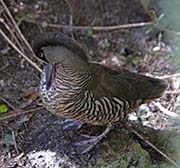Pink-eared Duck - Malacorhynchus membranaceus
| Length | |
| Wingspan | |
| Clutch Size | |
| Chicks at birth | |
| IUCN Conservation Status | |
Continents: |
The Pink-eared Duck is an Australian bird that is the only living member of the genus Malacorhynchus. The Pink-eared name comes from the slight pink spot above the ears. Another name for this duck is the Zebra Duck because of the bold brown and white stripes on the body.
Pink-eared Ducks have a white face with a dark brown crown that extends down the neck and back. They have black eye patches with a slight white eye-ring. The body is barred in brown and white stripes. The upper tail coverts are white, the under tail coverts are buff, and the tail is dark gray with white bars. The bill is gray and has an elongated upper mandible that has soft flaps near the tip which hang below the lower mandible. The iris is brown and the legs and feet are gray.
Both sexes are similar with the female slightly smaller. Juveniles are similar to adults but the pink ear patch is less distinct.
Diet: They eat plankton, crustaceans, mollusks and insects and their bill is designed for straining minute organisms. They also feed by two ducks spinning about a central point tail to head which helps concentrate the food in a water column.
Courtship: Pink-eared Ducks can breed any time of the year depending on the environmental conditions. Males courtship may include chin lifting and associated calling.
Nesting: Nests are placed above flooded waters in shrubs, fence posts or logs, trees. Because nests sites may be limited, nests sites can contain multiple broods. The typical brood size is 3-11 eggs. The female broods the clutch while the male defends the nest size and helps call the ducklings out of the nest. Ducklings can immediately start using their bill to strain out nourishment.
Habitat and Range: Pink-eared Ducks are widely distributed throughout Australia. They requirement is access to water which can be lakes or areas that have been flooded.
Vocalization: Pink-eared Ducks produce a high-pitched trilling or chirping sounds.
Plumage/Molt Pink-eared Duck do not have an alternative or breeding plumage and probably molt annually.
Migration: They don't migrate but they are nomadic.
Tongue/feet: Their legs and feet are gray.
Bibliography:
- http://en.wikipedia.org The Free Encyclopedia, Accessed July, 2012
- http://birdlife.org BirdLife International, Accessed July, 2012
- Johnsgard, Paul, Ducks, Geese, and Swans of the World,University of Nebraska-Lincoln Press, 1978


